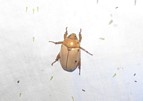
Last Updated: 19-AUG-2018
This was the first bug lighting of 2011. With the wet spring and a dry hot summer I was expecting a very good night and we had one. Also, we had three locations set up this time. The usual spot in the back yard and then two other locations on the property. Also, this time we had visitors. First, Warren Steiner (retired but very active from the Smithsonian) and his wife Jil. Also, Jil & Warren brought their guests Bill Johnson & wife from Minnesota. Bill is a professional nature photographer so I did not take as many photos as I usually do.
Bill Johnson Nature Stock Photography, Inc. pages
Weather Condition
Camera used: Cannon PowerShot S90
Sunset was at 20:38 Very Slight Wind, no dew and the sky was clear.
TIME WIND GUST HUMIDITY TEMP20:20 0 52 79.5 20:40 0 56 77.5 21:00 0 59 76.6 21:20 0 62 76.0 21:40 3 65 74.1 22:00 3 67 73.9 22:20 3 68 73.6 22:40 3 69 74.3 23:00 3 70 73.9 23:20 3 71 73.8 23:40 4 73 73.6 00:00 3 75 72.9 00:20 0 77 71.8 00:40 0 79 70.9
Click on image to make it larger
Using the same 400w mercury vapor light as other times we have done this. Set up around 20:20... and ended at 12:40
Grapevine Beetles, Pelidnota punctata
Polyphemus Moth (Antheraea polyphemus)
Azalea Sphinx
katydid - Tettigoniidae
Waved Sphinx
Ichneumon wasp
Great Leopard Moth (confirmed)
Datana contracta – Contracted Datana Moth
Some type of Orbweaver spider making use of my electric fences.
Cool looking 1/3rd moon setting
Regal moth or Royal walnut moth (adult)
What the orange moth above will become -- hickory horned devil (larva) Found near here in 2005 The hickory horned devil is among the largest of our native saturniid caterpillars (12.5 to 14 cm in length - about the size of a large hot dog) They vary slightly in color, but are commonly blue-green. The second and third thoracic segments each bear two long and two shorter orange, black-tipped scoli. Abdominal segments each have four short, black scoli, and segments 2 to 8 have a pale, oblique lateral stripe. Although the larva has a fierce appearance, it is harmless.
Virgo Tiger Moth
Fish Fly - Neuroptera, similar to a dobsonfly - just with less bite.
View of house and main buglighting station from 1/2 way down in the front. (was holding the camera when I took this 8 second exposure)
Rosy Maple Moth - Dryocampa rubicunda
Pearly Wood-Nymph - Eudryas unio (Sometimes referred to as the "bird poop moth" because of it's unique camouflage)